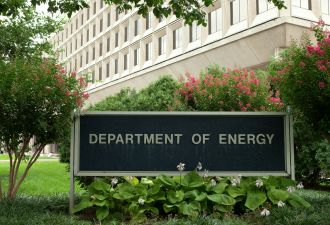Democratic presidential candidates Bernie Sanders and Elizabeth Warren, want grid operator ISO New England to give renewable energy a bigger role and fossil-fuel-fired generators a smaller one.
That’s the gist of a Tuesday letter signed by Warren, Sanders and the senators representing Massachusetts, Connecticut and Rhode Island, taking issue with what they call ISO-NE’s “patchwork of market reforms aimed at preserving the status quo of a fossil-fuel-centered resource mix.”
ISO New England's slow shift toward wind and solar is a problem for states with aggressive renewable energy and carbon reduction goals, wrote Sanders and Warren, both New Englanders themselves.
Tuesday’s letter highlights a growing disconnect between states promoting renewable energy, energy efficiency and other carbon-free resources, and federally regulated interstate energy market operators like ISO-NE and mid-Atlantic grid operator PJM, where baseload coal and nuclear power plants are struggling against low-cost natural gas and zero-marginal-cost renewable energy.
Over the past two years, both PJM and ISO-NE have taken up reforms aimed at securing grid capacity and reliability amid these shifting market conditions. But the resulting changes — helped along by some controversial decisions from a Federal Energy Regulatory Commission (FERC) now dominated by Trump administration appointees — could end up effectively barring renewable energy from participating in the region’s multibillion-dollar capacity markets, critics warn.
UPDATE: ISO-NE CEO Gordon van Welie responded in a Thursday letter, writing that "ISO New England understands and respects the policy objectives of the New England states with regard to the decarbonization of the bulk power system." At the same time, FERC has ordered ISO-NE to "file changes to the region’s wholesale energy markets by April 15, 2020 to address New England’s energy-security challenges," he wrote.
Capacity market rules take a toll
Tuesday’s letter takes up three ISO-NE policies for specific critique. The first is called Competitive Auctions With Sponsored Policy Resources, or CASPR (PDF), a complicated effort to balance zero-marginal-cost wind and solar power against fossil fuel and nuclear-powered generators in ISO-NE’s forward capacity auction.
The program was approved by FERC in March 2018, and ISO-NE held its first auction under the CASPR rules in February. While the auction cleared nearly 35,000 megawatts of capacity resources at an average price of $3.80 per kilowatt-month, the lowest price in six years, it also included only 145 megawatts of renewable energy, out of about 300 megawatts of the limited pool of solar and solar-storage resources allowed to participate.
What barred most renewables from participating is a market mechanism known as a minimum offer-price rule, or MOPR, created to prevent market manipulators from injecting artificially low prices into the process. But FERC’s 3-2 vote last year approving ISO-NE’s program included a provision, added by the Republican majority, calling for the MOPR to be used as a blanket mechanism to manage “impacts of state policies on the wholesale capacity markets.”
FERC’s two Democratic commissioners dissented, saying that assigning an artificial minimum price to low-cost, state-subsidized resources could effectively bar them from capacity markets and thus from being counted as grid resources by grid operators. Tuesday’s letter agreed that ISO-NE’s use of a MOPR in its CASPR regulation “forces state-sponsored renewable energy to wait for incumbent fossil fuel generators to retire before these clean resources can enter the capacity market.”
But FERC has only expanded its application of the concept. In an even more controversial 3-2 vote last summer, FERC declared PJM’s current capacity market to be “unjust and unreasonable” and required it to apply a MOPR to state-subsidized resources in the future. That could exempt gigawatts of renewable and nuclear energy from participating in the country’s biggest capacity market, which has now been delayed for more than six months as FERC has failed to take up PJM’s proposed replacement plan.
The debate over grid resilience vs. fuel security
Warren, Sanders and the other senators also criticized ISO-NE’s programs aimed at providing market support to “fuel-secure” generation resources. The Trump administration has sought for years to promote regulations that would reward coal and nuclear power plants, which store fuel on site, for providing essential reliability services for the grid.
An Energy Department rulemaking that would have forced out-of-market payments to “fuel-secure” plants was unanimously rejected by FERC in early 2018. But in the same vote, FERC created a new order for the country’s grid operators to examine the resilience of their systems against mega-storms, cyberattacks and other threats.
According to Tuesday’s letter, ISO-NE’s programs aimed at securing grid resilience are adding costs while failing to meet their intended purpose. For example, ISO-NE’s Inventoried Energy Program, created last year to secure generation resources to meet demand during winter cold snaps, is expected to add about $150 million per year in energy costs to New England consumers while providing questionable winter resilience benefits.
ISO-NE’s latest initiative, aimed primarily at “fuel security” for natural-gas-fired power plants, also threatens to “ignore the reliability and other benefits of clean energy, and further delays market reforms that recognize and facilitate state public policies to grow clean energy and address climate change,” the senators wrote.
Unclear forecast at FERC
Tuesday’s letter notes that multiple parties in New England support a realignment of ISO-NE’s efforts “beyond the current, too-narrow fuel security reforms.” What they’d like to see instead is a return to a 2016 plan, dubbed "integrating markets and public policy," which was developed by stakeholders including state governments, generator groups, utilities and energy retailers.
It’s unclear how Tuesday’s letter may affect ISO-NE’s decision-making or shift its approach to meeting the regulatory roadmap being laid out by its federal regulator. FERC now has two Republicans and one Democrat on its five-member board, leaving it with a bare quorum that has put it in the position of being unable to vote on key decisions, including PJM’s capacity market.
The Trump administration has declined to nominate a Democrat to replace Cheryl LaFleur, the sole Obama appointee remaining at FERC, who departed in September. But it has nominated James Danly, a 2013 law school graduate with scant energy industry expertise who has served as FERC general counsel since 2017, to become FERC’s third Republican commissioner.




